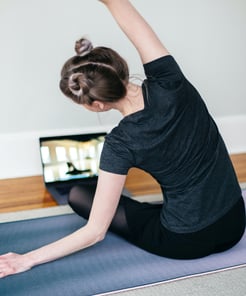6 Ways to Break Your Quarantine Habits and Prioritize Your Well-Being

COVID-19 has created a perfect storm for those who struggle with bad habits. With the sudden closure of gyms and concern over public exposure, many people have struggled with how to remain healthy and active during these unusual times. On top of changes to physical well-being, the pandemic has taken a toll on many people’s mental well-being as well.
A survey conducted in July found that 53% of adults had experienced negative consequences to their mental health as a direct result of the coronavirus. The biggest impacts to their mental health and well-being were reported as difficulty sleeping (36%), poor appetite and overeating (32%), increased alcohol consumption (12%), frequent headaches or stomach aches (18%), and the worsening of chronic conditions (12%).
With the mass-adoption of home exercise apps, it may feel like working out at home has never been easier. But in reality, it’s never been harder. As many Americans work remotely out of their homes, and may have children doing at-home learning, temptations and stress are ever-present. With constant access to the pantry and distracting technology, it’s difficult to make healthy choices and the guilt can quickly become debilitating.
But in reality, it’s never been harder. As many Americans work remotely out of their homes, and may have children doing at-home learning, temptations and stress are ever-present. With constant access to the pantry and distracting technology, it’s difficult to make healthy choices and the guilt can quickly become debilitating.
It's important to remember that you're not alone. There are more resources than ever to support you in taking control of your mental and physical wellbeing. Below, we'll share easy, actionable tips you can use to re-prioritize your health and break those bad quarantine habits.
1. Be Kind and Break Habits
The first step in your health journey is to have compassion (for others, but especially for yourself). We tend to criticize ourselves more harshly than others, but change isn’t born out of negativity. Be kind to yourself as you begin making healthy life choices and be mindful when harmful thoughts creep in.
Remember, weight loss and exercise routines may provide the appearance of control, but they can sometimes result in added anxiety. The average woman spends 21 minutes a day thinking or talking about her diet and most adults spend 20 minutes a day counting calories.
Focusing on unattainable goals or feeling pressure to maintain a certain weight or body size can have harmful effects on your mental health. You need to break the cycle of focusing on the scale and think of this as building a healthy, sustainable lifestyle.
Shifting focus away from the scale and negative thoughts allow one to set goals that are realistic and enforce positive mindsets.
2. Set S.M.A.R.T Goals for Big Results
As mentioned above, setting actionable and attainable goals can dramatically affect your well-being and long-term success. Many trainers and coaches incorporate S.M.A.R.T. goal techniques into their programs and they are often used in corporate wellness programs as well.
S.M.A.R.T. goals can be implemented by following these guidelines:
- Specific: Refine your goal into a specific milestone you’d like to achieve. For physical wellness goals, it may help to speak to a doctor or nutritionist who can evaluate your health and set specific goals based on your vitals and BMI. Instead of setting a specific weight goal, consider a behavioral goal like meal prepping your weekday lunches or working out 3 times a week.

- Measurable: Your goal must be measurable so you can track your progress during the journey. Behavioral goals can be tracked in a spreadsheet or calendar and fitness goals can be tracked via activity bands or fitness apps. A good example would be setting a goal to walk for 30 minutes every day and tracking the progress on a smartwatch each week.
- Attainable: To be successful, your goals must be feasibly attainable. For example, setting a goal to exercise daily when you haven’t worked out for months may be setting you up for failure. Adjust goals based on your current capabilities and remember that you can always re-adjust your goals or set new ones along the way.
- Relevant: Understanding the importance of your goal is a key way to stay motivated. For example, changing your health habits may be relevant if you want to stay active for your children.
- Time-Bound: Your goals should have a time limit that is reasonable to achieve. For physical wellness, avoid setting ambitious time limits that are impossible to hit. For behavioral goals, set an end-date to check in on progress.
3. Prioritize Your Mental Health
Making a commitment to your health is only possible by incorporating mental health into the conversation.
When your mental health suffers, it can lead to a compromised immune system, meaning you can get sick easier and stay sick longer. Prolonged mental health conditions can bring about feelings of tiredness and exhaustion, which are counterproductive in building a healthy lifestyle. In the worst case, ongoing stress can even have damaging consequences to your long-term heart health.
To prioritize your mental health, introduce self-care activities, commit to a sleep schedule, make healthy food choices, exercise, and seek appropriate treatments for any conditions.
4. Utilize Your Corporate Wellness Program
Employee wellness programs have become increasingly common and valued resources for individuals looking to create healthier lifestyles. A study in 2017 found that 69% of worksites had a health promotion program in place for over three years. With the global pandemic, more employers are enhancing their healthcare benefits and broadening existing wellbeing offerings.
Anyone with access to a corporate wellness program should consider this a key resource in their health journey. Wellness programs provide more than just on-demand access to health assessments, virtual coaching, wellness challenges, exercise regimens, behavior change programs, and mental health resources. They’ve been proven to reduce annual healthcare costs, support long-term disease management, and increase an individual’s productivity.
5. Create a Sustainable Routine
Routines are critical for creating lasting change. As you introduce healthy habits to your life make sure they are sustainable. If you want to become a runner but you’ve never been a morning person, it may not be sustainable to commit to running every morning. Instead, consider a routine that optimizes your time so you can stick with your commitments over prolonged periods.
6. Never Underestimate the Power of a Good Night's Sleep
Keeping to a sleep schedule of seven or more hours per night minimizes the damaging effects of depression, anxiety, and stress.
If you are struggling with falling or staying asleep, consider one of the following tactics:
- Relax or meditate before bed
- Lower your caffeine intake (especially later in the day)
- Solidify a schedule for bedtime and commit to that routine
- Limit screen time before bedtime
Break Your Quarantine Habits and Prioritize Your Well-Being
Committing to a healthier lifestyle takes time and requires a combination of mental and behavioral changes. Start by setting your S.M.A.R.T. goals and leveraging available resources to help you make lasting changes.
Corporate wellness programs can be a massive benefit to employees who are looking to take their health into their own hands.
About CoreHealth Technologies
CoreHealth Technologies Inc. is a total well-being technology company trusted by global providers to power their health and wellness programs. Our wellness portals help maximize health, engagement and productivity for 3+ million employees worldwide. We believe people are the driving force of organizations and supporting them to make behavior changes to improve employee health is in everyone’s best interest. With the most flexibility, customizations and integrations of any software in its class, CoreHealth’s all-in-one wellness platform helps grow great wellness companies. Simple to sophisticated, based on you. For more information, visit the CoreHealth website.
About The Author
Your Friends in Health at CoreHealth
CoreHealth by Carebook's Health and Wellness Team works hard to bring our readers informative and research validate health and well-being blog articles and resources that support your workplace wellness culture and wellness technology purchase decision.


